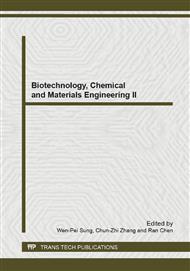[1]
R. Martin, The Chemistry of Phenolic Resins, Wiley, New York, (1956).
Google Scholar
[2]
A. Knop, W. Scheib, Chemistry and Application of Phenolic Resins; Springer: New York, (1979).
Google Scholar
[3]
A. Knop, L. A. Pilato, Phenolic Resins: Chemistry, Applications, Performance and Future Direction, Berlin, Springer, (1985).
Google Scholar
[4]
C. Chmielewski, K. Jayaraman, C. A. Petty, Polym. Com. 14 (1993) 257.
Google Scholar
[5]
B. S. Hayes, J. C. Seferis, R. R. Edwards, Self-adhesive honeycomb prepreg systems for secondary structural applications, Polym. Com. 19 (1998) 54-64.
DOI: 10.1002/pc.10075
Google Scholar
[6]
C. P. Reghunadhan Nair, Advances in addition-cure phenolic resins Progress in Polymer Science. 29 (2004) 401-498.
DOI: 10.1016/j.progpolymsci.2004.01.004
Google Scholar
[7]
R. L. Bindu, C. P. Reghunadhan Nair, K. N. Ninan, Phenolic resins with phenyl maleimidefunctions: Thermal characteristics and laminate composite properties, J. Appl. Polym. Sci. 80 (2001) 1664-1674.
DOI: 10.1002/app.1261
Google Scholar
[8]
J. Hunter, K. L. Forsdyke, Phenolic glass fiber-reinforced plastic and its recent applications, Polym. Compo. 2 (1989) 85-169.
Google Scholar
[9]
D. G. Hepworth, D. M. Bruce, J. F. V. Vincent, G. Jeronimidis, The manufacture and machanical testing of thermosetting natural fibre composites, J. Mater. Sci. 35 (2000) 293-298.
Google Scholar
[10]
M. Molyneux, P. Murry, Prepreg, tape and fabric technology for advanced composites, Composites. 14 (1983) 87-91.
DOI: 10.1016/s0010-4361(83)80003-2
Google Scholar
[11]
K. J. Ahn, J. C. Seferis, Prepreg processing science and engineering, Polym. Eng. & Sci. 33 (1993) 1177-1188.
DOI: 10.1002/pen.760331805
Google Scholar
[12]
A.G. Gibson, J. A. Manson, Impregnation technology for thermoplastic matrix composites, Composites Manufacturing. 3 (1992) 223-233.
DOI: 10.1016/0956-7143(92)90110-g
Google Scholar
[13]
J. Wolfrum, G. W. Ehrenstein, Interdependence between the curing, structure, and the mechanical properties of phenolic resins, J. Appl. Polym. Sci. 74 (1999) 3173-3185.
DOI: 10.1002/(sici)1097-4628(19991220)74:13<3173::aid-app21>3.0.co;2-6
Google Scholar
[14]
M. -F. Grenier-Loustalot, G. Raffin, B. Salino, Phenolic resins Part 6. Identifications of volatile organic molecules during thermal treatment of neat resols and resol filled with glass fibers, Polymer. 41 (2000) 7123-7132.
DOI: 10.1016/s0032-3861(00)00045-8
Google Scholar
[15]
M. N. Charalambides, J. M. Williams, Fracture toughness characterization of phenolic resin and its composite, Polym. Compo. 16 (1995) 17-28.
DOI: 10.1002/pc.750160105
Google Scholar
[16]
C. S. Tyberg, K. Bergeron, M. Sankarapandian, P. Shih, A. C. Loos, Structure–property relationships of void-free phenolic–epoxy matrix materials, Polymer. 41 (2000) 5053-5062.
DOI: 10.1016/s0032-3861(99)00574-1
Google Scholar
[17]
U. Yashitaka, T. Takayuki, F. Yasuo, US patent 5, 284, 702. (1994).
Google Scholar
[18]
M. George, Prepregs—raw material for high-performance composites, Reinforced plastics. 46 (2002) 24-28.
DOI: 10.1016/s0034-3617(02)80172-2
Google Scholar
[19]
C. Chmielewski, K. Jayaraman, C. A. Petty, Processing effects in production of composite prepreg by hot melt impregnation, Polym. Compo. 14 (1993) 257-264.
DOI: 10.1002/pc.750140311
Google Scholar
[20]
B. S. Hayes, J. C. Seferis, S. Chen. Judy, Development and hot-melt impregnation of a model controlled flow prepreg system, Polym. Compo. 17 (1996) 730-742.
DOI: 10.1002/pc.10665
Google Scholar
[21]
G. A. Richard, J. M. Micheal, M. K. John, E. H. Kenneth, US patent 4, 804, 509. (1989).
Google Scholar
[22]
H. Tilmann, R. Kolja, S. Christian, US patent 6, 716, 376 B1. (2004).
Google Scholar
[23]
J. D. Ferry, Viscoelastic Properties of Polymers, Wiley, New York, (1980).
Google Scholar
[24]
S. B. Christopher, L. R. Stephen, Fundamental Principles of Polymeric Materials, Wiley, Hoboken, (1993).
Google Scholar


